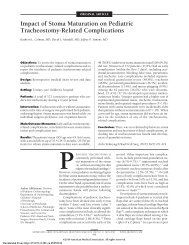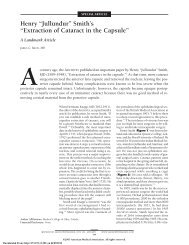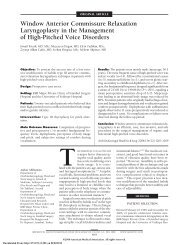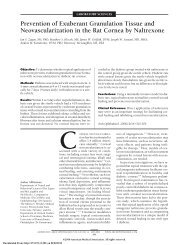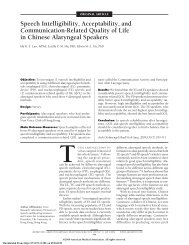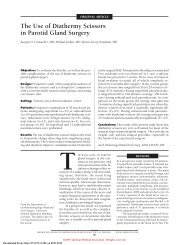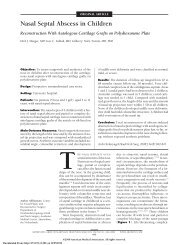Pilocarpine Tablets for the Treatment of Dry Mouth and Dry Eye ...
Pilocarpine Tablets for the Treatment of Dry Mouth and Dry Eye ...
Pilocarpine Tablets for the Treatment of Dry Mouth and Dry Eye ...
Create successful ePaper yourself
Turn your PDF publications into a flip-book with our unique Google optimized e-Paper software.
PATIENTS AND METHODS<br />
PATIENTS<br />
Written <strong>of</strong> in<strong>for</strong>med consent was obtained from all potential<br />
study participants as <strong>the</strong> first stage <strong>of</strong> screening <strong>and</strong> be<strong>for</strong>e<br />
admission to <strong>the</strong> study. Study patients were older than<br />
18 years <strong>and</strong> had a diagnosis <strong>of</strong> primary or secondary SS<br />
consistent with <strong>the</strong> European Cooperative Community classification<br />
criteria <strong>for</strong> SS. 10 The diagnosis <strong>of</strong> SS was confirmed<br />
at screening by positive test results <strong>for</strong> at least 1 <strong>of</strong><br />
<strong>the</strong> following: marker autoantibodies against SS-A or SS-B,<br />
rheumatoid factor or antinuclear antibodies at a titer <strong>of</strong> 1:<br />
160 or greater (or equivalent), or a positive labial minor<br />
salivary gl<strong>and</strong> biopsy sample. If a lip biopsy sample was used<br />
to support admission to <strong>the</strong> study, a representative slide<br />
<strong>of</strong> <strong>the</strong> biopsy sample was read by an external evaluator<br />
(T. E. Daniels, DDS, MS, Oral Pathology Laboratory, School<br />
<strong>of</strong> Dentistry, University <strong>of</strong> Cali<strong>for</strong>nia, San Francisco). Positive<br />
biopsy samples required a focus score <strong>of</strong> greater than<br />
1 focus per 4 mm 2 tissue area. 3,11 The presence <strong>of</strong> clinically<br />
significant dry mouth <strong>and</strong> dry eye symptoms was confirmed<br />
by screening questionnaires. Patients who indicated<br />
mild symptoms by responding in <strong>the</strong> upper quartile<br />
<strong>of</strong> <strong>the</strong> screening questionnaire (100-mm visual analog scale<br />
[VAS]) did not qualify <strong>for</strong> entry. Patients were required to<br />
discontinue, <strong>for</strong> at least 6 weeks be<strong>for</strong>e screening procedures,<br />
use <strong>of</strong> any electrical device <strong>for</strong> salivary stimulation.<br />
At screening, patients were required to demonstrate some<br />
residual salivary function by demonstrating any level <strong>of</strong> saliva<br />
production. In <strong>the</strong>se analyses, an unstimulated wholemouth<br />
salivary flow rate <strong>of</strong> less than 0.4 mL/min was classified<br />
as salivary hyp<strong>of</strong>unction. 12 Patients were instructed<br />
to discontinue, at least 7 days be<strong>for</strong>e admission, taking any<br />
medication reported to produce significant dry mouth. 13,14<br />
Schirmer tear test results <strong>and</strong> Rose Bengal staining 15 were<br />
also recorded during screening. A Schirmer score <strong>of</strong> 7 mm<br />
per 5 minutes <strong>and</strong> staining <strong>of</strong> 3 were each considered indicative<br />
<strong>of</strong> dry eyes. These screening requirements were<br />
modified from <strong>the</strong> European classification criteria <strong>for</strong> SS, 10<br />
which requires a patient to meet 4 <strong>of</strong> <strong>the</strong> following 6 criteria:<br />
ocular symptom, oral symptom, ocular sign, histopathologic<br />
feature, objective salivary gl<strong>and</strong> involvement,<br />
<strong>and</strong> presence <strong>of</strong> autoantibodies.<br />
Prospective patients were excluded if <strong>the</strong>y had clinically<br />
significant cardiopulmonary, renal, or gastrointestinal<br />
tract disease; diabetes mellitus; multiple sclerosis; hypersensitivity<br />
to pilocarpine use; or clinically significant<br />
ocular disease, including narrow-angle glaucoma, peripheral<br />
retinopathies, or o<strong>the</strong>r conditions in which ocular<br />
(topical) pilocarpine use would be contraindicated. Female<br />
patients <strong>of</strong> childbearing potential were required to<br />
pilocarpine tablets provided significant relief to patients<br />
with radiation-induced dry mouth. In <strong>the</strong>se 2 studies, use<br />
<strong>of</strong> pilocarpine tablets significantly improved symptoms<br />
<strong>of</strong> intraoral dryness, oral discom<strong>for</strong>t, <strong>and</strong> dysphonia <strong>and</strong><br />
patients’ global assessment <strong>of</strong> dry mouth as well as reduced<br />
<strong>the</strong> need <strong>for</strong> administration <strong>of</strong> oral com<strong>for</strong>t agents<br />
such as artificial saliva, water, <strong>and</strong> hard c<strong>and</strong>y. Patients<br />
treated with pilocarpine tablets also demonstrated a statistically<br />
significant increase in saliva production, mea-<br />
Downloaded From: http://173.193.11.201/ on 04/10/2013<br />
use medically acceptable contraceptive methods throughout<br />
<strong>the</strong> study.<br />
TREATMENT PROTOCOL<br />
At <strong>the</strong> admission visit, patients were r<strong>and</strong>omly assigned to 1<br />
<strong>of</strong> 3 treatment groups <strong>for</strong> <strong>the</strong> duration <strong>of</strong> <strong>the</strong> study:2.5-mg pilocarpine,5-mgpilocarpine,orplacebotablets.Alltabletswere<br />
identicalinappearance<strong>and</strong>weresuppliedbyMGIPharmaInc,<br />
Minnetonka, Minn. Site personnel instructed patients to take<br />
1 tablet <strong>of</strong> <strong>the</strong> study drug with water 4 times a day at mealtimes<br />
<strong>and</strong> bedtime, with a minimum <strong>of</strong> 3 hours between doses <strong>for</strong><br />
<strong>the</strong> duration <strong>of</strong> <strong>the</strong> 12-week study. In addition, patients were<br />
instructed to record missed doses <strong>and</strong> adverse experiences in<br />
a diary. Patients recorded <strong>the</strong>ir responses to <strong>the</strong> dryness questionnaires<br />
be<strong>for</strong>e receiving <strong>the</strong> first dose <strong>of</strong> <strong>the</strong> test drug. At<br />
this visit, patients who took nothing by mouth <strong>for</strong> at least 90<br />
minutes be<strong>for</strong>e <strong>the</strong> start <strong>of</strong> salivary procedures were given <strong>the</strong><br />
first dose <strong>of</strong> test drug with 180 mL (6 oz) <strong>of</strong> water. They were<br />
<strong>the</strong>n monitored <strong>for</strong> an additional 90 minutes, during which<br />
timesalivasampleswereobtained(see<strong>the</strong>“Methods”section).<br />
All baseline measurements were recorded <strong>for</strong> each patient be<strong>for</strong>e<br />
administration <strong>of</strong> this first dose <strong>of</strong> test drug. Patients returnedto<strong>the</strong>studysiteatweeks6<strong>and</strong>12<strong>for</strong>efficacy<strong>and</strong>safety<br />
evaluations.<br />
METHODS<br />
Efficacy Assessment<br />
Efficacy was evaluated at each visit by (1) response to questionnaires<br />
<strong>and</strong> (2) measurement <strong>of</strong> salivary flow. Primary<br />
variables were <strong>the</strong> global assessments <strong>of</strong> dry mouth <strong>and</strong> dry<br />
eyes at study end point. End point was defined as <strong>the</strong> last<br />
available postdose observation <strong>for</strong> each patient. In addition,<br />
specific symptoms associated with dry mouth <strong>and</strong> dry<br />
eyes were assessed, as was change in dryness associated with<br />
extraoral <strong>and</strong> extraocular symptoms, such as dryness <strong>of</strong> <strong>the</strong><br />
skin, vagina, <strong>and</strong> nasal passages.<br />
Questionnaires<br />
ARCH INTERN MED/ VOL 159, JAN 25, 1999<br />
175<br />
©1999 American Medical Association. All rights reserved.<br />
Patients completed questionnaires at <strong>the</strong> admission (baseline),<br />
week 6, <strong>and</strong> week 12 visits. Questions were presented<br />
in 2 <strong>for</strong>mats: (1) a 100-mm VAS, with responses ranging<br />
from <strong>the</strong> negative (0 mm = extremely dry) on <strong>the</strong> left<br />
to <strong>the</strong> positive on <strong>the</strong> right, <strong>and</strong> (2) 3-point categorical questions<br />
(increase in, no change, or decrease in symptoms). 8,9<br />
For assessment <strong>of</strong> primary measures <strong>of</strong> efficacy—<br />
global improvement <strong>of</strong> dry mouth <strong>and</strong> dry eyes—patients<br />
were asked at each week 6 <strong>and</strong> week 12 visit to indicate on<br />
Continued on next page<br />
sured as ei<strong>the</strong>r whole-mouth or parotid salivary flow. It<br />
is through this mechanism that cholinergic stimulation<br />
<strong>of</strong> residual-functioning exocrine gl<strong>and</strong>ular tissue in patients<br />
with SS could potentially alleviate symptoms <strong>of</strong> dry<br />
mouth, dry eyes, or o<strong>the</strong>r symptoms associated with SS.<br />
There<strong>for</strong>e, <strong>the</strong> present study was undertaken to investigate<br />
<strong>the</strong> efficacy <strong>and</strong> safety <strong>of</strong> pilocarpine tablets <strong>for</strong> <strong>the</strong><br />
treatment <strong>of</strong> symptoms associated with dry mouth <strong>and</strong><br />
dry eyes in patients with SS.



